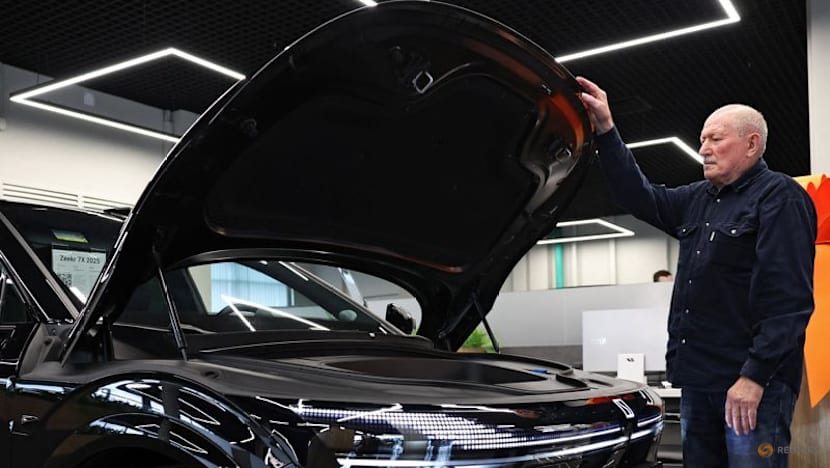Chinese car sales skid in Russia as Moscow tightens regulations
After dominating the Russian market, Chinese carmakers have seen sales plunge nearly 30 per cent this year.


This audio is generated by an AI tool.
MOSCOW: After several years of spectacular growth, Chinese car sales in Russia have hit the brakes as Moscow moves to bolster its domestic auto industry.
Chinese carmakers had in recent years made major inroads in Russia, as international brands exited following Moscow’s invasion of Ukraine.
Last year, Russia imported more than a million vehicles from China, handing Chinese brands a 63 per cent share of the market, up from just 7 per cent in 2021.
But this squeezed out Russian automakers. Local manufacturers commanded just 29 per cent of the market share in 2024, according to the China Passenger Car Association.
In January, Russian authorities stepped in by raising "recycling fees" – mandatory levies on future car disposal – by up to 85 per cent.
Industry analyst Alexander Klimnov from Avtostat Info said the move was aimed at curbing imports of fully-assembled cars, notably from China.
"The recycling fee is, in essence, a tax that is giving advantage to the local producers; they are being compensated for it,” he told CNA.
“Russian cars are being subsidised, whereas foreign-made cars are, in essence, levied with what one could call an additional tax, similar to the existing tax on luxury goods."
The move has made imported cars more expensive, forcing Chinese dealerships to slash prices to woo customers and clear excess stock.
The sales of Chinese-made cars dropped nearly 30 per cent in the first nine months of 2025.
SAFETY CONCERNS
Adding to Chinese carmakers’ woes, customer complaints about the reliability and safety of some models have been growing louder.
"They are unreliable,” said one taxi driver in Moscow. “I constantly had to have my car towed for repairs. The pump would fall off, then the transmission, or the air conditioner would not work, or something else."
Last Friday (Oct 17), China’s top electric vehicle maker BYD announced its largest recall yet of more than 115,000 cars due to design defects and battery-related safety risks.
But quality and reliability vary widely among Chinese brands, depending on the segment, said Danil Pivovarov, director of business development at analytical firm Autostat.
Low-end, mass-market models often use older technology and can be less reliable or durable, and this could be behind the negative perception among Russian drivers, he told CNA’s East Asia Tonight.
Higher-end Chinese cars – such as Zeekr and BYD’s premium arm Yangwang – are much stronger in terms of design and technology, he said, adding that the overall quality of Chinese cars is improving rapidly.
BUYERS PRICED OUT
Analysts say behind the Kremlin’s protectionist move is an attempt to plug its widening budget deficit as energy export revenues decline. It expects about US$73 billion in revenue over the next three years from recycling fees.
“Energy exports have fallen significantly. This needs to be compensated for somehow in the budget,” said Klimnov.
Yet, observers say the fee hike has had the opposite effect, dampening sales of all new cars as Russian automakers raised prices along with their competitors.
In the first three quarters of this year, overall new car sales declined by 23 per cent.
With high inflation and steep interest rates, many Russians are being priced out of the car market.
“The introduction of the new recycling fee will likely cut the middle class from the purchase of a car,” said one Moscow resident.
LOCALISATION PUSH
Moscow has also mandated that cars – and all new taxis – boast a minimum number of Russia-made components.
The policy is aimed at supporting domestic production, but observers say it could raise prices further.
Tselikov Sergey, another director at Autostat, said the localisation fee incentivises Chinese car manufacturers to set up shop in Russia.
“Those companies that produce and have a certain level of localisation are entitled to a refund of this recycling fee and, accordingly, can lower their prices,” he explained.
“This means they have lower production costs. Further increases in the fee are aimed at the same thing – to encourage Chinese brands to localise.”
Pivovarov said he expects car prices to rise by 20-25 per cent in 2026, which will eventually improve margins for Chinese brands that build locally.
“It means that the situation for Chinese manufacturers who come to open their assembly plants … in Russia in some years, will be better because prices have risen,” he said.
Touching on Moscow-Beijing relations, Pivovarov added that the tension within the auto industry was a small “situational” crack rather than a major rift in their “no-limits” partnership.
Both countries are also trying to balance economic cooperation with concerns about Western sanctions, he added. Chinese car brands have also been hit by tariffs in Europe over state subsidies.
Pivovarov said there will likely be mutual benefits for both Chinese and Russian carmakers in about two years’ time, as “prices will be increased for both … and they will earn more margins”.
















